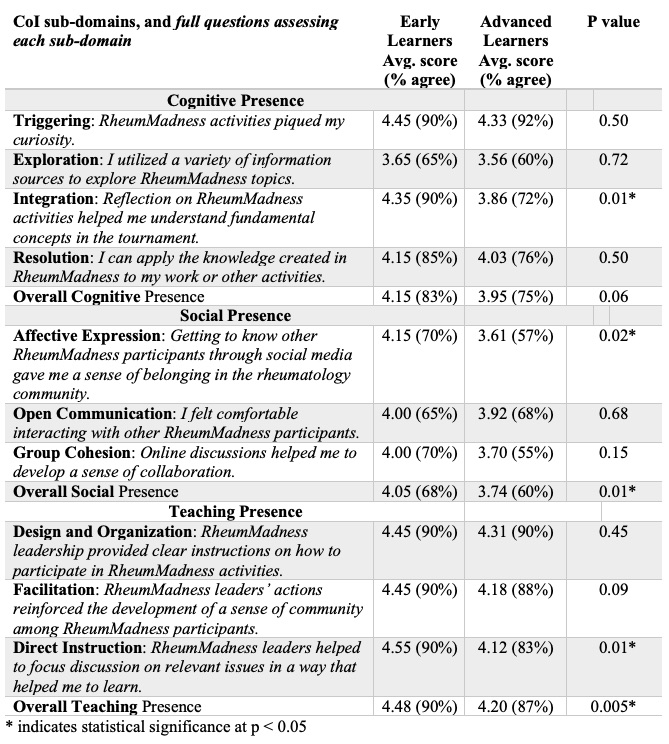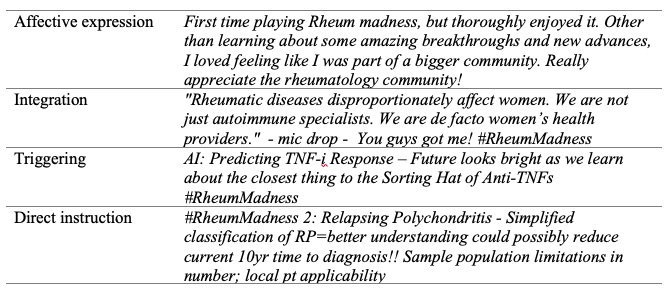Back
Poster Session A
Professional development and education
Session: (0214–0240) Professional Education Poster
0232: RheumMadness: Early Learner Experience and Impact
Saturday, November 12, 2022
1:00 PM – 3:00 PM Eastern Time
Location: Virtual Poster Hall
- LH
Lauren He, MD
University of Chicago
Chicago, IL, United States
Abstract Poster Presenter(s)
Lauren He1, Ben Kellogg2, Michael Macklin3, Courtney Bair2, Guy Katz4, Aki Garren5, matthew Sparks2, Lisa Criscione-Schreiber2 and david leverenz2, 1University of Chicago, Chicago, IL, 2Duke University School of Medicine, Durham, NC, 3University of Chicago Medical center, Chicago, IL, 4Massachusetts General Hospital, Boston, MA, 5MedStar/Georgetown Washington Hospital Center, Silver Spring, MD
Background/Purpose: RheumMadness is an online educational initiative developed to engage learners of all levels in social constructivist learning. Participants were recruited via social media, email, and word of mouth to complete a March Madness style bracket of 16 teams, representing learning concepts in rheumatology. Additional curricular elements included scouting reports reviewing each team, a podcast series, and social media-based discussion. One objective of RheumMadness is to engage medical students and residents in the rheumatology learning community. Therefore, in this analysis we seek to understand these learners' experiences in the 2021 and 2022 RheumMadness tournaments.
Methods: Participants were emailed a survey at the completion of the 2021 and 2022 tournaments. For this analysis, we aggregated responses from early learners (medical students and residents) and advanced learners (attendings and fellows). Incomplete survey responses were excluded. Surveys assessed participants' self-reported engagement with each curricular element according to a 5-point scale (1=never, 5=a great deal/every day). Learner experience was assessed according to Community of Inquiry (CoI) presences and sub-domains, as follows: cognitive (triggering, exploration, integration, and resolution), social (affective expression, open communication, group cohesion), and teaching (course design, facilitation, and direct instruction), according to a 5-point scale (1=strongly disagree, 5=strongly agree). Early learners were asked what impact RheumMadness had on their interest in rheumatology, with social media posts and survey comments from early learners reviewed to further explore their experiences. Survey responses from early versus advanced learners were compared with unpaired T-tests.
Results: Of 116 included respondents in 2021 and 2022, 17% (20/116) were early learners (4 medical students and 16 residents) and 83% (96/116) were advanced (50 attendings and 46 fellows). There was no significant difference between early and advanced learners in self-reported engagement with RheumMadness scouting reports, podcasts, or social media (Figure 1). Early learners reported stronger learning experiences in knowledge integration (p=0.01), affective expression (p=0.02), the overall social presence (p=0.01), direct instruction (p=0.01), and the overall teaching presence (p=0.005), (Table 1). Early learners' interest in rheumatology was impacted by RheumMadness as follows: 17 (85%) increased, 3 (15%) no change, 0 (0%) decreased. Social media posts and survey comments further illustrate early learners' experiences (Table 2).
Conclusion: Early and advanced learners had similar patterns of engagement in RheumMadness. However, early learners indicated that RheumMadness helped them understand fundamental concepts in the tournament (knowledge integration) and gave them a sense of belonging in the rheumatology community (affective expression) more than advanced learners. Thus, RheumMadness is a useful tool for increasing interest in rheumatology and connecting interested trainees to this specialty.
.jpg) Early learners and advanced learners reported similar levels of engagement. Participants were asked to estimate their frequency of interacting with reading scouting reports, listening to podcasts, reading/posting social media using the following scale: 1=never, 2=rarely (once or twice), 3=occasionally (about once per week), 4=a moderate amount (several times per week), 5=a great deal (about every day). The bars represent average Likert scores ±1 standard deviation for each group.
Early learners and advanced learners reported similar levels of engagement. Participants were asked to estimate their frequency of interacting with reading scouting reports, listening to podcasts, reading/posting social media using the following scale: 1=never, 2=rarely (once or twice), 3=occasionally (about once per week), 4=a moderate amount (several times per week), 5=a great deal (about every day). The bars represent average Likert scores ±1 standard deviation for each group.
 Early learners reported more engagement in most CoI sub-domains, most notably integration, affective expression, overall social presence, direct instruction, and overall teaching presence. Data are represented by average Likert scores for each CoI question (scale 1-5) and % agree, which represents the percent of participants who chose agree (4) or strongly agree (5) in each sub-domain.
Early learners reported more engagement in most CoI sub-domains, most notably integration, affective expression, overall social presence, direct instruction, and overall teaching presence. Data are represented by average Likert scores for each CoI question (scale 1-5) and % agree, which represents the percent of participants who chose agree (4) or strongly agree (5) in each sub-domain.
 Sample Twitter and post-survey comments with associated sub-domains expressed.
Sample Twitter and post-survey comments with associated sub-domains expressed.
Disclosures: L. He, None; B. Kellogg, None; M. Macklin, None; C. Bair, None; G. Katz, None; A. Garren, None; m. Sparks, Renal Research Institute, American Board of Internal Medicine, NephJC, American Journal of Kidney Diseases, Kidney360, Kidney Medicine, ASN Kidney News, KCVD Membership & Communications Committee- AHA, Elsevier- Nephrology Secrets, KCVD Scientific & Clinical Education Lifelong Learning Committee (SCILL)- AHA, NKF North Carolina; L. Criscione-Schreiber, GlaxoSmithKlein(GSK), UCB; d. leverenz, Pfizer, Rheumatology Research Fund.
Background/Purpose: RheumMadness is an online educational initiative developed to engage learners of all levels in social constructivist learning. Participants were recruited via social media, email, and word of mouth to complete a March Madness style bracket of 16 teams, representing learning concepts in rheumatology. Additional curricular elements included scouting reports reviewing each team, a podcast series, and social media-based discussion. One objective of RheumMadness is to engage medical students and residents in the rheumatology learning community. Therefore, in this analysis we seek to understand these learners' experiences in the 2021 and 2022 RheumMadness tournaments.
Methods: Participants were emailed a survey at the completion of the 2021 and 2022 tournaments. For this analysis, we aggregated responses from early learners (medical students and residents) and advanced learners (attendings and fellows). Incomplete survey responses were excluded. Surveys assessed participants' self-reported engagement with each curricular element according to a 5-point scale (1=never, 5=a great deal/every day). Learner experience was assessed according to Community of Inquiry (CoI) presences and sub-domains, as follows: cognitive (triggering, exploration, integration, and resolution), social (affective expression, open communication, group cohesion), and teaching (course design, facilitation, and direct instruction), according to a 5-point scale (1=strongly disagree, 5=strongly agree). Early learners were asked what impact RheumMadness had on their interest in rheumatology, with social media posts and survey comments from early learners reviewed to further explore their experiences. Survey responses from early versus advanced learners were compared with unpaired T-tests.
Results: Of 116 included respondents in 2021 and 2022, 17% (20/116) were early learners (4 medical students and 16 residents) and 83% (96/116) were advanced (50 attendings and 46 fellows). There was no significant difference between early and advanced learners in self-reported engagement with RheumMadness scouting reports, podcasts, or social media (Figure 1). Early learners reported stronger learning experiences in knowledge integration (p=0.01), affective expression (p=0.02), the overall social presence (p=0.01), direct instruction (p=0.01), and the overall teaching presence (p=0.005), (Table 1). Early learners' interest in rheumatology was impacted by RheumMadness as follows: 17 (85%) increased, 3 (15%) no change, 0 (0%) decreased. Social media posts and survey comments further illustrate early learners' experiences (Table 2).
Conclusion: Early and advanced learners had similar patterns of engagement in RheumMadness. However, early learners indicated that RheumMadness helped them understand fundamental concepts in the tournament (knowledge integration) and gave them a sense of belonging in the rheumatology community (affective expression) more than advanced learners. Thus, RheumMadness is a useful tool for increasing interest in rheumatology and connecting interested trainees to this specialty.
.jpg) Early learners and advanced learners reported similar levels of engagement. Participants were asked to estimate their frequency of interacting with reading scouting reports, listening to podcasts, reading/posting social media using the following scale: 1=never, 2=rarely (once or twice), 3=occasionally (about once per week), 4=a moderate amount (several times per week), 5=a great deal (about every day). The bars represent average Likert scores ±1 standard deviation for each group.
Early learners and advanced learners reported similar levels of engagement. Participants were asked to estimate their frequency of interacting with reading scouting reports, listening to podcasts, reading/posting social media using the following scale: 1=never, 2=rarely (once or twice), 3=occasionally (about once per week), 4=a moderate amount (several times per week), 5=a great deal (about every day). The bars represent average Likert scores ±1 standard deviation for each group. Early learners reported more engagement in most CoI sub-domains, most notably integration, affective expression, overall social presence, direct instruction, and overall teaching presence. Data are represented by average Likert scores for each CoI question (scale 1-5) and % agree, which represents the percent of participants who chose agree (4) or strongly agree (5) in each sub-domain.
Early learners reported more engagement in most CoI sub-domains, most notably integration, affective expression, overall social presence, direct instruction, and overall teaching presence. Data are represented by average Likert scores for each CoI question (scale 1-5) and % agree, which represents the percent of participants who chose agree (4) or strongly agree (5) in each sub-domain.  Sample Twitter and post-survey comments with associated sub-domains expressed.
Sample Twitter and post-survey comments with associated sub-domains expressed.Disclosures: L. He, None; B. Kellogg, None; M. Macklin, None; C. Bair, None; G. Katz, None; A. Garren, None; m. Sparks, Renal Research Institute, American Board of Internal Medicine, NephJC, American Journal of Kidney Diseases, Kidney360, Kidney Medicine, ASN Kidney News, KCVD Membership & Communications Committee- AHA, Elsevier- Nephrology Secrets, KCVD Scientific & Clinical Education Lifelong Learning Committee (SCILL)- AHA, NKF North Carolina; L. Criscione-Schreiber, GlaxoSmithKlein(GSK), UCB; d. leverenz, Pfizer, Rheumatology Research Fund.

